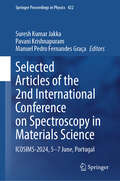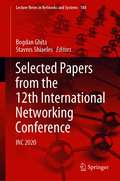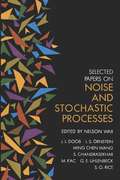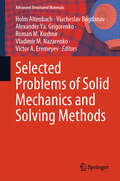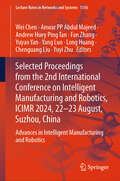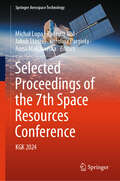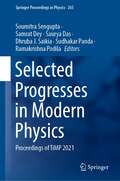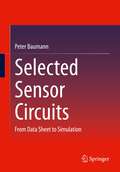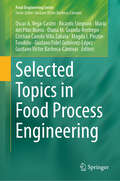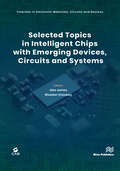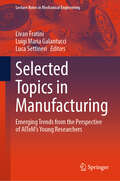- Table View
- List View
Selected Articles of the 2nd International Conference on Spectroscopy in Materials Science: ICOSIMS-2024, 5-7 June, Portugal (Springer Proceedings in Physics #422)
by Suresh Kumar Jakka Pavani Krishnapuram Manuel Pedro Fernandes GraçaThis volume compiles selected articles from the 2nd International Conference on Spectroscopy in Materials Science (ICOSIMS-2024) held online on June 5-7 2024. It offers insights into recent developments in analytical techniques and spectroscopic methods vital to materials science. Hosted by the Department of Physics at the University of Aveiro, Portugal, the conference gathered experts across various fields to discuss innovative research and applications. The book covers topics such as light-matter interaction, materials characterization, and photon and phonon dynamics, featuring contributions from both established and emerging scholars. Spectroscopic techniques like infrared to ultraviolet-visible Raman, nuclear magnetic resonance, X-ray crystallography and mass spectrometry are highlighted, addressing challenges in nanotechnology, biomedicine, and energy research. Emphasizing interdisciplinary collaboration, the volume includes contributions from participants from 15 countries. Keynote speeches and invited talks stimulated valuable discussions and knowledge exchange, prompting readers to explore new questions and methodologies influencing the future of spectroscopy. Intended for researchers, educators, and professionals in physics, chemistry, biology, and engineering, this conference proceedings volume serves as a resource for those seeking to deepen their understanding and stay informed on recent advancements in spectroscopy and materials science.
Selected Contributions of 2024 2nd International Conference on Electric Vehicle and Vehicle Engineering (Lecture Notes in Electrical Engineering #1424)
by Jun Xu Pak Kin WongThis book presents an extensive exploration of the latest trends in Electric Vehicle and the boundless opportunities they offer. It has encompassed various facets including Intelligent Vehicle, Electric Vehicle Technology, Power Electronics and Motor Drives, Energy Systems and Storage, Electronic Control Systems, Battery Technologies, Autonomous and Connected Vehicles. The book is tailored for researchers, engineers, and practitioners deeply involved in the field of Electric Vehicle. It delves into the intricate technicalities of EV technology, providing profound insights and comprehensive discussions on its fundamental principles.
Selected Papers from ICIR EUROINVENT - 2023: International Conference on Innovative Research (Springer Proceedings in Materials #38)
by Petrica Vizureanu Mohd Mustafa Al Bakri Abdullah Andrei Victor Sandu Marcin Nabialek Che Mohd Ruzaidi Ghazali Ion SanduThis book is a collection of research papers presented at the International Conference on Innovative Research, a part of EUROINVENT 2023, held under the patronage of Romanian Ministry of Research Innovation and Digitization. The book features contributions from leading researchers, engineers, and students who have presented their insights and experiences on a wide range of topics in the field of Materials Science and Engineering. The papers cover advancements, innovations, and future directions in the field, and are grouped into sections based on the themes discussed at the conference. The book is a valuable resource for researchers, students, and professionals interested in the latest developments in materials science and engineering.
Selected Papers from the 12th International Networking Conference: INC 2020 (Lecture Notes in Networks and Systems #180)
by Bogdan Ghita Stavros ShiaelesThe proceedings includes a selection of papers covering a range of subjects focusing on topical areas of computer networks and security with a specific emphasis of novel environments, ranging from 5G and virtualised infrastructures to Internet of things, smart environments and cyber security issues. Networking represents the underlying core of current IT systems, providing the necessary communication support for complex infrastructures. Recent years have witnessed a number of novel concepts moving from theory to large scale implementations, such as Software Defined Networking, Network Function Virtualisation, 5G, smart environments, and IoT. These concepts change fundamentally the paradigms used in traditional networking, with a number of areas such as network routing and system or business security having to adjust or redesign to accommodate them. While the benefits are clear, through the advent of new applications, use cases, improved user interaction and experience, they also introduce new challenges for generic network architectures, mobility, security, traffic engineering.
Selected Papers from the International Conference on Innovative Research: ICIR EUROINVENT 2024 (Springer Proceedings in Materials #64)
by Petrica Vizureanu Mohd Mustafa Al Bakri Abdullah Andrei Victor Sandu Marcin Nabialek Ion Sandu Mohd Remy Rozainy Mohd Arif ZainolThis book is a collection of research papers presented at the International Conference on Innovative Research, a part of EUROINVENT 2024, held under the patronage of Romanian Ministry of Research Innovation and Digitization. The book features contributions from leading researchers, engineers, and students who have presented their insights and experiences on a wide range of topics in the field of Materials Science and Engineering. The papers cover advancements, innovations, and future directions in the field, and are grouped into sections based on the themes discussed at the conference. The book is a valuable resource for researchers, students, and professionals interested in the latest developments in materials science and engineering.
Selected Papers on Noise and Stochastic Processes
by Nelson WaxSix classic papers on stochastic process, selected to meet the needs of physicists, applied mathematicians, and engineers. Contents: 1.Chandrasekhar, S.: Stochastic Problems in Physics and Astronomy. 2. Uhlenbeck, G. E. and Ornstein, L. S.: On the Theory of the Browninan Motion. 3. Ming Chen Wang and Uhlenbeck, G. E.: On the Theory of the Browninan Motion II. 4. Rice, S. O.: Mathematical Analysis of Random Noise. 5. Kac, Mark: Random Walk and the Theory of Brownian Motion. 6. Doob, J. L.: The Brownian Movement and Stochastic Equations. Unabridged republication of the Dover reprint (1954). Preface.
Selected Perspectives on Platforms in E-Commerce Ecosystems: Recommendations for the Design and Management of Boundary Resources and Guidance on the Orchestration of Ecosystem Participants
by Tobias WulfertDigital platforms hold significant economic value, enriching various industry sectors. While they are pivotal in driving value creation and capture, it is not solely their technological prowess that underpins their economic significance. Rather, their effectiveness lies in their integration within business ecosystems. In this study, Tobias Wulfert examines digital platforms in the context of e-commerce through five lenses: · Enterprise architecture · Boundary resources · Application lifecycle · Dynamic capabilities · Value creation This analysis focuses on different e-commerce platform types, developing an architectural framework and a taxonomy for classification. The author also delineates e-commerce ecosystem architectures, emphasizing the role of platforms as central components and the involvement of peripheral ecosystem participants. He explores boundary resources as crucial interfaces between platforms and ecosystem participants. He further suggests a reference procedure model for the management of these boundary resources. Furthermore, he delves into the dynamic capabilities necessary for effective ecosystem orchestration, identifying configurations of dynamic capabilities that can confer sustainable competitive advantages.
Selected Philosophical And Scientific Writings (Jossey-bass Guides To Online Teaching And Learning)
by Judith P. Zinsser Isabelle Bour Emilie Du ChâteletThough most historians remember her as the mistress of Voltaire, Emilie Du Châtelet (1706–49) was an accomplished writer in her own right, who published multiple editions of her scientific writings during her lifetime, as well as a translation of Newton’s Principia Mathematica that is still the standard edition of that work in French. Had she been a man, her reputation as a member of the eighteenth-century French intellectual elite would have been assured. In the 1970s, feminist historians of science began the slow work of recovering Du Châtelet’s writings and her contributions to history and philosophy. For this edition, Judith P. Zinsser has selected key sections from Du Châtelet’s published and unpublished works, as well as related correspondence, part of her little-known critique of the Old and New Testaments, and a treatise on happiness that is a refreshingly uncensored piece of autobiography—making all of them available for the first time in English. The resulting volume will recover Châtelet’s place in the pantheon of French letters and culture.
Selected Problems in the Elastodynamics of Piezoceramic Bodies (Advanced Structured Materials #154)
by Alexander Ya. Grigorenko Wolfgang H. Müller Igor A. LozaThis book presents various dynamic processes in non-uniform piezoceramic cylindrical and spherical bodies based on numerical methods. It discusses different variants of nonhomogeneous structural polarized piezoceramic materials in the shape of cylinders and spheres, and highlights the validation of the reliability of the results obtained by numerical calculations. The content is based on an outlined theory and methods of three-dimensional electroelasticity problems.
Selected Problems of Solid Mechanics and Solving Methods (Advanced Structured Materials #204)
by Alexander Ya. Grigorenko Holm Altenbach Victor A. Eremeyev Vladimir M. Nazarenko Viacheslav Bogdanov Roman M. KushnirThis book examines new approaches for the estimation of errors in approximate theories. Numerical and analytical methods in mechanics often require the establishment of a set of basic equations, and various approaches exist to create approximate theories from them. The problem is that nobody knows the boundaries of the estimation of errors in approximate theories. This book presents new approaches to overcome this problem and to provide the reader with suitable methods for the relevant field, including a representation of different scientific schools and different countries. These new methods are helping to solve many problems not only in analytical Mechanics but also in Physics, Mathematics, and Civil Engineering.
Selected Proceedings from the 2nd International Conference on Intelligent Manufacturing and Robotics, ICIMR 2024, 22-23 August, Suzhou, China: Advances in Intelligent Manufacturing and Robotics (Lecture Notes in Networks and Systems #1316)
by Fan Zhang Wei Chen Long Huang Anwar PP Abdul Majeed Andrew Huey Ping Tan Yuyao Yan Yang Luo Chenguang Liu Yuyi ZhuThis book presents proceedings from the 2nd International Conference on Intelligent Manufacturing and Robotics, ICIMR 2024 Held on 22 and 23 August in Suzhou, China. This proceedings deliberates on the key challenges, engineering and scientific discoveries, innovations, and advances on intelligent manufacturing and robotics that are non-trivial through the lens of Industry 4.0. In this book, traditional and modern solutions that are employed across the spectrum of various intelligent manufacturing and robotics contexts are presents. The readers are expected to gain an insightful view on the current trends, issues, mitigating factors as well as proposed solutions from this book.
Selected Proceedings of the 1st International Conference on Advanced Materials for Sustainable Innovation; IC-AMSI 2024; 28–30 August; New Delhi; India: Harnessing Sustainable Energy Technologies for Effective Decarbonization (Springer Proceedings in Energy)
by Brian Norton G. N. Tiwari Anil Kumar Deepak TiwariThis book presents peer-reviewed articles from the 1st International Conference on Advanced Materials for Sustainable Innovation (IC-AMSI 2024) held on Aug 28–30 in New Delhi, India. It delves into four key themes shaping the future of sustainable energy as follows: Emerging Technologies for Clean Energy Production: It explores the forefront of renewable energy research. Cutting-edge advancements in renewable sources, energy storage, and smart grids are unveiled, promising enhanced efficiency and sustainability in energy production. Integration of Sustainable Solutions in Energy Systems: Through meticulous analysis, it highlights the seamless incorporation of sustainable technologies into existing energy infrastructures. Emphasis is placed on optimizing energy systems to maximize their impact on decarbonization. Digitalization and Smart Energy Management: It investigates the transformative role of digital technologies, artificial intelligence, and smart energy management. This section illuminates how these innovations revolutionize energy consumption patterns, playing a pivotal role in minimizing carbon footprints. Policy and Regulatory Frameworks for Decarbonization: Readers gain insights into the evolving landscapes of policies and regulatory frameworks that underpin the deployment of sustainable energy technologies. The exploration of these frameworks creates a conducive environment for the effective implementation of decarbonization strategies. &“Innovative Pathways&” offers a multidimensional perspective, uniting technological exploration with strategic insights to guide the future of sustainable energy initiatives.
Selected Proceedings of the 2nd International Engineering Research Symposium; IERS 2024; 14 Aug; Colombo, Sri Lanka: Engineering Innovations for Economic Transformation (Proceedings in Technology Transfer)
by Ranjith Dissanayake Meththika Vithanage Pradeep Gajanayake T. Nilanthi Fernando Manjula Siriwardhana Jayathu G. SamarawickramaThis book presents selected peer reviewed articles from the 2nd International Engineering Research Symposium- IERS 2024, held at Colombo in Sri Lanka, under the theme of 'Engineering Innovations for Economic Transformation”. It highlights the latest advancements in engineering research, innovations, and technological principles aimed at driving economic changes and improvements within society and the industry. IERS2024 covers the areas of Agricultural Engineering, Chemical Engineering, Civil Engineering, Computer Science & Engineering, Electrical Engineering, Electronics & Telecommunication Engineering, Mechanical & Mechatronics Engineering, Materials Science & Engineering, Manufacturing & Process Engineering, and other Engineering discipline relevant to the theme of IERS 2024.
Selected Proceedings of the 6th Space Resources Conference: KGK 2023 (Springer Aerospace Technology)
by Katarzyna Malinowska Agata Kołodziejczyk Joanna Pyrkosz-Pacyna Krzysztof Grabowski Olga SergijenkoThis book collects advances, innovations, and applications in the field of space resources and exploration, as presented by international researchers at the 6th Space Resources Conference (KGK), held in Kraków, Poland on May 15-16, 2023. The conference serves as a forum for discussion on the state-of-the-art technologies applicable to current challenges of space exploration, the use of space resources to improve the living conditions of humans and protect Earth’s natural environment, and the latest research results on space resource extraction, transportation, manufacturing in space, and how to develop settlements on the Moon and Mars. Topics include bioastronautics and life support systems, Earth observation and sensors issues, space law, subspace missions, space industry, society and space, space education, and space structures design and operations. The book, which was selected by means of a rigorous peer-review process, presents a wealth of exciting ideas that will open novel research directions and foster multidisciplinary collaboration among different specialists.
Selected Proceedings of the 7th Space Resources Conference: KGK 2024 (Springer Aerospace Technology)
by Tadeusz Uhl Michał Lupa Jakub Staszel Karolina Pargieła Anna MalczewskaThis book collects advances, innovations, and applications in the field of space resources and exploration, as presented by international researchers at the 7th Space Resources Conference (KGK), held in Kraków, Poland, on May 23–24, 2024. The book serves as a forum for discussion on the state-of-the-art technologies applicable to current challenges of space exploration, the use of space resources to improve the living conditions of humans and protect Earth&’s natural environment, and the latest research results on space resource extraction, transportation, manufacturing in space, and how to develop settlements on the Moon and Mars. Topics include bioastronautics and life support systems, Earth observation and sensors issues, space law, subspace missions, space industry, society and space, space education, and space structures design and operations. The book, which is selected by means of a rigorous peer-review process, presents a wealth of exciting ideas that will open novel research directions and foster multidisciplinary collaboration among different specialists.
Selected Progresses in Modern Physics: Proceedings of TiMP 2021 (Springer Proceedings in Physics #265)
by Saurya Das Soumitra Sengupta Samrat Dey Dhruba J. Saikia Sudhakar Panda Ramakrishna PodilaThis book presents peer-reviewed articles from the 1st International Conference on Trends in Modern Physics (TiMP 2021) held at Assam Don Bosco University in Guwahati, India, between February 26 and 27, 2021. This conference was the 3rd in a series of annual conferences of the Department of Physics, ADBU, with the 1st and 2nd being national conferences. The conference was jointly organized by the Department of Physics, ADBU, and the Indian Association of Physics Teachers (IAPT) to promote greater synergy between thematic areas of astrophysics and cosmology, plasma physics, material and nanophysics, nuclear physics, and particle physics
Selected Sensor Circuits: From Data Sheet to Simulation
by Peter BaumannThis book shows the steps from data sheets of sensors to the extraction of model parameters for the program PSPICE in order to realize circuit analyses. Physical ENTITIES as temperature, humidity, light, pressure and sound are included by equations. The simulation concerns temperature displays, characteristics of humidity-sensors, light-to-voltage Converters, strain gauges, reed relays and Piezol-electric-sounders US-Converters and SAW Components
Selected Studies in Geomorphology, Sedimentology, and Geochemistry: Proceedings of the 3rd Conference of the Arabian Journal of Geosciences (CAJG-3) (Advances in Science, Technology & Innovation)
by Jasper Knight Sandeep Panda Broder Merkel Stefan Grab Sami Khomsi Amjad Kallel Santanu Banerjee Haroun Chenchouni Domenico M. Doronzo Helder I. Chaminé Jesús Rodrigo-Comino Federico Lucci Anna TravéThis book is based on the papers accepted for presentation during the 3rd Springer Conference of the Arabian Journal of Geosciences (CAJG-3). The book is of interest to all researchers in the fields of geomorphology, sedimentology, and geochemistry. Papers in the field of geomorphology deal with topics related to fault slip and incision rates, soil science, landslides and debris flows, coastal processes, and geoarcheology and geoheritage. Papers in the field of sedimentology cover research studies in stratigraphy and environmental, tectonic, and diagenetic processes, together with studies focusing on the evolutionary, biostratigraphic, and paleo-environmental significance of paleontology. This section also contains papers on marine geosciences, from molecular proxies related to climate to geophysical surveys. The third set of papers focuses on studies related to geochemistry that are focused on sedimentary geochemistry and mineralogical characterization, magmatic and metamorphic processes and products, and the origin and exploration of mineral deposits. This book resumes the current situation related to the abovementioned topics mainly in the Mediterranean realm and its surroundings. The book is of interest to all researchers, practitioners, and students in the fields of geomorphology, sedimentology, and geochemistry.
Selected Topics in Micro/Nano-robotics for Biomedical Applications
by Yi GuoMicro/Nano-robotics for Biomedical Applications features a system approach and incorporates modern methodologies in autonomous mobile robots for programmable and controllable micro/nano-robots aiming at biomedical applications. The book provides chapters of instructional materials in micro/nanorobotics for biomedical applications. The book features lecture units on micro/nanorobot components and techniques, including sensors, actuator, power supply, and micro/nano-fabrication and assembly. It also contains case studies on using micro/nano-robots in biomedical environments and in biomedicine, as well as a design example to conceptually develop a Vitamin-pill sized robot to enter human's gastrointestinal tract. Laboratory modules to teach robot navigation and cooperation methods suitable to biomedical applications will be also provided based on existing simulation and robot platforms.
Selected Topics in Biomedical Circuits and Systems (Tutorials In Circuits And Systems Ser.)
by Minkyu Je Myung Hoon SunwooIntegrated circuits and microsystems play a vital role in a variety of biomedical applications including life-saving/changing miniature medical devices, surgical procedures with less invasiveness and morbidity, low-cost preventive healthcare solutions for daily life, solutions for effective chronic disease management, point-of-care diagnosis for early disease detection, high-throughput bio sequencing and drug screening and groundbreaking brain-machine interfaces based on a deep understanding of human intelligence. In response to such strong demands for biomedical circuits and systems, a considerable amount of effort has been devoted to the research and development in this area, both by industry and academia, over recent years.This book, which belongs to the “Tutorials in Circuits and Systems” series, provides readers with an overview of new developments in the field of biomedical circuits and systems. It covers basic information about system-level and circuit-level requirements, operation principles, key factors of considerations, and design/implementation techniques, as well as recent advances in integrated circuits and microsystems for emerging biomedical applications.Technical topics covered in this book include: Biomedical Microsystem Integration; Biomedical Sensor Interface Circuits; Neural Stimulation Circuits; Wireless Power Transfer Circuits for Biomedical Microsystems; Artificial Intelligence Processors for Biomedical Circuits and Systems; Neuro-Inspired Computing and Neuromorphic Processors for Biomedical Circuits and Systems.This book is ideal for personnel in medical devices and biomedical engineering industries as well as academic staff and postgraduate/research students in biomedical circuits and systems.
Selected Topics in Food Process Engineering (Food Engineering Series)
by Ricardo Simpson Gustavo Fidel Gutiérrez-López María del Pilar Buera Oscar A. Vega-Castro Diana M. Granda-Restrepo Cristian Camilo Villa Zabala Magda I. Pinzón-Fandiño Gustavo Victor Barbosa-CánovasThis text is based on the invited presentations at the XIII Ibero-American Congress of Food Engineering (CIBIA XIII) which was held in Medellín, Colombia, in March 2022. Invited presentations were delivered by renowned food engineers worldwide and covered the latest on classic and novel topics driving food process engineering. The selected topics are centered on how food process engineering is addressing new challenges related to technical, social, economic and environmental realities. Selected Topics in Food Process Engineering covers important ground in current and future food processing, including: Food engineering contributions to health, environment and quality of life The role of food engineering during pandemics Modeling of food processes Clean technologies for the processing and preservation of foods Alternative thermal and nonthermal processes, challenges and opportunities to the food industry Advancesin the characterization of food properties Nanotechnology in food processing Starch digestion Extraction processes in the food industry Food factory of the future This text serves as an inspirational tool for future research in food engineering and beyond as it promotes the well-being of the population in terms of adequate food supply by bridging engineering knowledge, the food chain and the fourth industrial revolution.
Selected Topics in Intelligent Chips with Emerging Devices, Circuits and Systems
by Alex James Bhaskar ChoubeyMemristors have provided a new direction of thinking for circuit designers to overcome the limits of scalability and for thinking of building systems beyond Moore’s law. Over the last decade, there has been a significant number of innovations in using memristors for building neural networks through analog computing, in-memory computing, and stochastic computing approaches. The emergence of intelligent integrated circuits is inevitable for the future of integrated circuit applications. This book provides a collection of talks conducted as part of the IEEE Seasonal School on Circuits and System, having a focus on Intelligence in Chip: Tomorrow of Integrated Circuits. Technical topics discussed in the book include: Edge of Chaos Theory Explains Complex Phenomena in Memristor Circuits Analog Memristive Computing Designing energy efficient neo-cortex system with on-device learning Integrated sensors Challenges and recent advances in NVM based Neuromorphic Computing ICs In-memory Computing (for deep learning) Deep learning with Spiking Neural Networks Computational Intelligence for Designing Integrated Circuits and Systems Neurochip Design, Modeling, and Applications
Selected Topics in Manufacturing: AITeM Young Researcher Award 2019 (Lecture Notes in Mechanical Engineering)
by Elisabetta Ceretti Tullio TolioThis book presents selected contributions on a wide range of scientific and technological areas covered by AITeM (the Italian Association of Manufacturing). It discusses the following topics: additive manufacturing, advanced and unconventional machining and processes, material removal processes, foundry and forming, tools and machine tools, assembly/disassembly, joining materials and material properties, quality metrology and material testing, manufacturing systems engineering, sustainable manufacturing, smart manufacturing and cyber-physical systems, education in manufacturing and human factors, industrial applications. Written by young AITeM associates, the contributions reflect the multifaceted nature of the research in manufacturing, which takes advantage of emergent technologies and establishes interdisciplinary connections with various scientific and technological areas to move beyond simple product fabrication and develop a complex and highly interconnected value creation processes ecosystem pursuing high-value-added products to compete globally.
Selected Topics in Manufacturing: AITeM Young Researcher Award 2021 (Lecture Notes in Mechanical Engineering)
by Tullio Tolio Luigi CarrinoThis book presents selected contributions on a wide range of scientific and technological areas covered by AITeM (the Italian Association of Manufacturing). It discusses the following topics: additive manufacturing, advanced and unconventional machining and processes, material removal processes, foundry and forming, tools and machine tools, assembly/disassembly, joining materials and material properties, quality metrology and material testing, manufacturing systems engineering, sustainable manufacturing, smart manufacturing and cyber-physical systems, education in manufacturing and human factors, industrial applications. Written by young AITeM associates, the contributions reflect the multifaceted nature of the research in manufacturing, which takes advantage of emergent technologies and establishes interdisciplinary connections with various scientific and technological areas to move beyond simple product fabrication and develop a complex and highly interconnected value creation processes ecosystem pursuing high-value-added products to compete globally.
Selected Topics in Manufacturing: Emerging Trends from the Perspective of AITeM's Young Researchers (Lecture Notes in Mechanical Engineering)
by Luigi Maria Galantucci Luca Settineri Livan FratiniThis book presents selected contributions covering various scientific and technological areas by AITeM (Italian Manufacturing Association). The first part, &“AITeM Young Researcher Award 2025,&” written by young AITeM associates, reflects the multifaceted nature of manufacturing research. It explores emerging technologies and interdisciplinary connections to go beyond product fabrication, developing a complex value creation ecosystem for high-value-added global competition. Topics include additive manufacturing, materials processing technology, assembly, disassembly, circular economy, manufacturing systems design and management, quality engineering, production metrology, process and system simulation, optimization, and digital manufacturing. The second part, &“White Papers,&” features three contributions on emerging trends in manufacturing. This book is prepared by Working Groups focusing on strategic research topics in the manufacturing sector, including adaptive processes for the manufacturing of welded profiles and tubes, sustainable and innovative production processes for composite materials, machining for aerospace. This book provides an overview of challenges in these frontier areas, highlighting the need for a multidisciplinary and innovative approach from the community to successfully address them.
